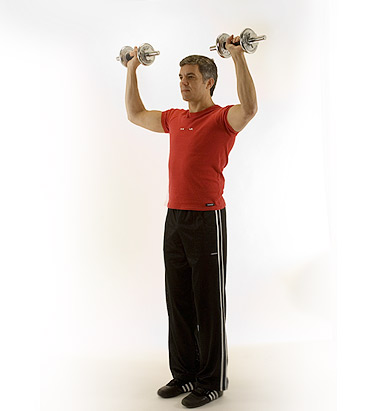
To begin the triceps strengthening exercise, lie on the floor with your back flat, your knees bent and your feet on the ground. Grip a small dumbbell with both hands. Rest your arms on your torso so that the weight is lying near your waist. While keeping your arms straight, slowly pull the weight behind you until it touches the floor behind your head, as shown in the figure. Slowly return to the starting position. Do this exercise 12 times.





 As with the stretching routine I laid out in the preceding chapter, the purpose of this section is to show you the minimum of what I think you should do in strength training, not present a one-size-fits-all strength training program. You might have noticed that everything I’ve said so far about strengthening exercises refers to upper body work. That’s what I’m going to focus on here. I’m not saying that runners can’t benefit from doing resistance training for their legs, just that I don’t think that doing so is as necessary for all runners as the upper body work.
As with the stretching routine I laid out in the preceding chapter, the purpose of this section is to show you the minimum of what I think you should do in strength training, not present a one-size-fits-all strength training program. You might have noticed that everything I’ve said so far about strengthening exercises refers to upper body work. That’s what I’m going to focus on here. I’m not saying that runners can’t benefit from doing resistance training for their legs, just that I don’t think that doing so is as necessary for all runners as the upper body work. Unfortunately, a lot of runners don’t believe a word of this advice. They like to point out that if a strong upper body were necessary to run well, then certainly you’d develop one through running. They also like to scare people away from trying to get stronger by warning that lifting weights will make you “muscle-bound” and add tons of unwanted bulk. After all, they’ll ask, wasn’t losing weight one of the main reasons you started running?
Unfortunately, a lot of runners don’t believe a word of this advice. They like to point out that if a strong upper body were necessary to run well, then certainly you’d develop one through running. They also like to scare people away from trying to get stronger by warning that lifting weights will make you “muscle-bound” and add tons of unwanted bulk. After all, they’ll ask, wasn’t losing weight one of the main reasons you started running?